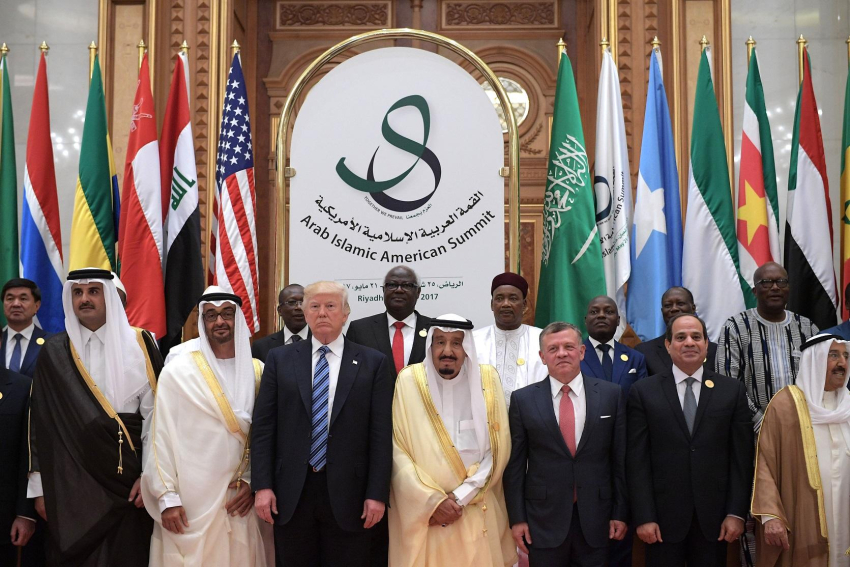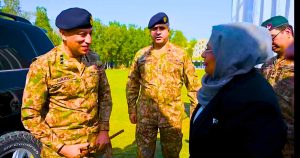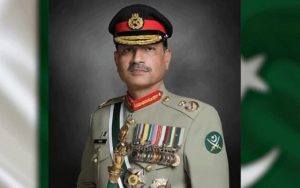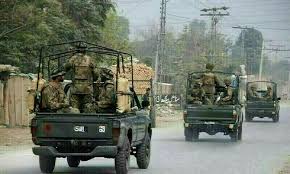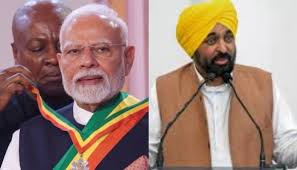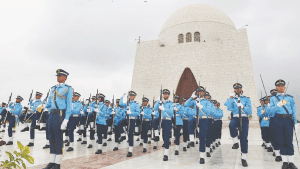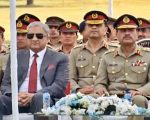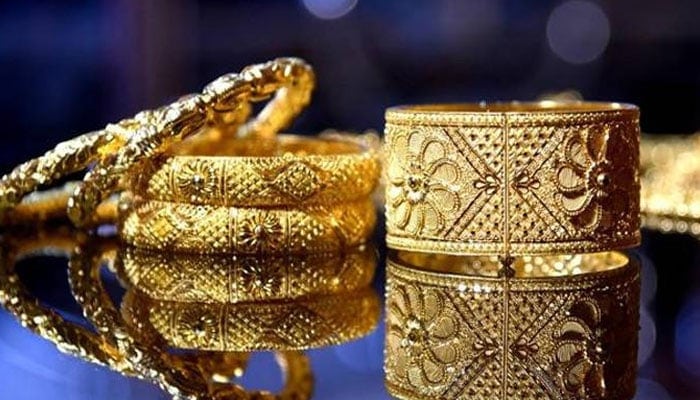When the White House announced Saudi Arabia to be the destination of President Donald J Trump’s first foreign assignment, the news received a mixed response. Then came the news that the man who flared Islamophobic sentiments on the campaign trail would be addressing an unprecedented gathering of top Muslim diplomats. Impulsively, Saudi Arabia and Trumps lovers and haters both shook their heads in disbelief. Thenceforth echoed quotes of Voltaire and what not about money driving faiths and politics. Isolated as it has been for its own doing, Iran suggested that the Great Satan discuss averting the next 9/11, a reference to the fact that the perpetrators of the 2001 attack were Saudi nationals. Foreign Minister Javed Zarif was soon reminded of the fact that his country had hosted al-Qaeda’s key leaders during the 1990s and even post-9/11.
Trump’s Saudi Arabia visit is being marked with grand receptions, splashy announcements and some bizarre images. It offered something to everyone, from click-bait hunters to anti-Trump and anti-Arab media houses, to a semblance of relief for the ones vulnerable to Iran’s aggressive asymmetrical warfare. Without departure from its tradition, Pakistani media and politicians missed the substance and the larger picture to merely focus on personal attacks against Prime Minister Nawaz Sharif while Kellyanne Conway-ing for ‘harmless’ Iran.
The US presidents have historically visited Saudi Arabia with similar fanfare. They are regaled with impressive welcome ceremonies and colossal defense and business deals. Besides, the timing and context of Trump’s visit amid dozens of Muslim leaders’ presence in Riyadh made global headlines. It’s significance as a bilateral affair is no less than its multilateral aspect.
The bilateral dimension
Primarily, the US President was on an official tour to the Kingdom of Saudi Arabia, and how this will foster the bilateral relations is still to be seen. Given the somewhat sour experience with the Obama administration, the Saudis focused on strengthening his successor at home while addressing the country’s core national interests. In pursuit of the Vision 2030, the Kingdom has long-term plans for investments abroad while diversifying the economy at home. The $40 billion investment in the US as well as $110 billion in arms purchase serve both sides.

The sheer volume of the weapons deal alarms the armchair analysts hedging for Iran’s domination across the greater Middle East. What they fail to comprehend is the fact that arms deal can’t be reached within the time frame of four months, which Donald J Trump has spent in the president’s office. The lengthy process of shortlisting, evaluating and bargaining the prices of a weapon system takes more than a year. Thus, the Saudi-US $110 billion arms purchase agreement was not an overnight affair between the two governments. In fact, the sales including new ships, tanks, armored vehicles, precision-guided bombs, missile defense and radar systems were principally agreed upon during the Obama administration. In a move to appease Donald Trump, Riyadh is pleased to let the president portray it as a brand-new venture. The weapons’ purchase has yet to be reviewed by Congressional oversight committees for approval. According to the US media, Lockheed Martin’s Terminal High Altitude Area Defense anti-missile system (THAAD), costing about $1 billion, is the only fresh addition to the shopping list.
The Saudis are also roping in the US for collaboration with the recently set up Saudi Arabian Military Industries, which aims to hire 40,000 employees till 2030 hoping for it to rank amongst top of the league in 15 years. Thus, the world’s top arms buyer makes a bid at self-reliance in military hardware.
While the Trump camp is portraying the mammoth arms deal as boost for economy and jobs, the Saudis describe it as natural progression of a relationship which was briefly marred by “Obama’s flawed priorities”.
The multilateral feature
At the multilateral level, the decision to offer Trump a platform to interact with over 55 top diplomats including many heads of state and head of governments resulted in the first US-Muslim summit-level interface on countering terrorism. Since it was the start of a process, expecting quick results would be imprudent. Neither will the American leader’s worldview of Islam change with it, nor will weary Muslim states’ fears be addressed. What other opportunities for interaction with Trump would exist had the KSA not arranged this mega event? The answer is anybody’s guess.
Trump’s speech was a reflection of his country’s policies. The most obvious miss – Pakistan’s fight against terror – is one vivid example of the US administration’s warped approach. Evidently, Islamabad’s outreach to Washington leaves a lot to be desired, given the heavy influence of the Indian diaspora as well as the government there.

Much of the debate about the Arab-Islamic-American leaders’ summit is marred with stereotypes and trivialities. For serious observers of geopolitics in the Middle East, US foreign policy and fight against terrorism, speeches merely offer declaratory policies of the leaders. If the US president and the Saudi king call for action against Iran for sponsoring of terrorism, it does not necessitate that top representatives of 50 countries under the same roof subscribe to their policy and the grand strategy. Multilateral fora are avenues for maximizing pursuit of national interests, whether by merely understanding the dynamics of issues or engaging at the partial or absolute level.
Only few people have analyzed the text of the final communiqué of the Arab-Islamic-American leaders’ summit. Not only does the document lay down the areas of consensus amongst the 55 participating nations but it also spells out the future course of action in the fight against extremism and terrorism.
According to the communiqué, the Riyadh Declaration concluded:
First: The close partnership between the leaders of Arab and Islamic countries and the US leader to confront extremism, terrorism, achieving peace, stability and development, on regional as well as international stages.

Second: Promotion of coexistence and constructive tolerance between different countries, religions and cultures.
Third: Confronting the sectarian agendas and interference in other countries affairs.
Fourth: Countering piracy and protecting navigation.
Fifth: the follow-up mechanisms include:
a. Establishment of a Middle East Strategic Alliance, to be set by 2018 in Riyadh, with the purpose to “contribute to peace and security in the region and the world.”
b. Setting up of a global center for countering radicalism “with strategic objectives of combating intellectual, media and digital extremism and promoting coexistence and tolerance among peoples.”
c. Formal launch of the Islamic Military Coalition to combat terrorism with a reserve force of 34,000 troops to support operations. The bloc is already in the works with General Raheel Sharif at the helm and working closely with Mohammad bin Salman, Saudi Arabia’s defense minister and deputy crown prince.
Regional stability vs anarchy

Under King Salman, Saudi Arabia has shunned the impression of a laid-back oil rich monarchy. The country is undergoing transition at various levels. While Riyadh aspires to shift its dependence on petrochemicals, the country is faced with the threat of asymmetrical warfare within and without. KSA’s belated bid for muscle flexing and global strategic realignment alarms Iran and its sympathizers even in countries with marginal Shiite population. Tehran knows that the Kingdom will not stop at the grand diplomatic gala but will follow it up with concrete measures.
Iran’s President Hassan Rouhani, who has won a second term in office, expressed a resolve to continue the country’s missile program, which is already vulnerable to fresh sanctions. Tehran will now be in a greater hurry to strengthen Bashar al-Assad in Syria while launching its own diplomatic coup against the Sunni states. Iran’s economy is struggling with significant external overheads of financing proxies in Syria, Iraq, Lebanon, Yemen, Afghanistan and Pakistan. Moreover, neither Russia’s economy nor its military technology can do the needful. Thus, Saudi Arabia and its allies will face more intense asymmetrical warfare, as it comes cheaper and with lesser political cost for the Ayatollah. Instead of détente, expect more disruption till Iran dominates the greater Middle East or implodes.
Saudi Arabia too has a tightrope walk ahead to economic diversification and regional leadership. The epic encounter between harbinger of the status quo and the architect of anarchy is not going to be ending any time soon.

